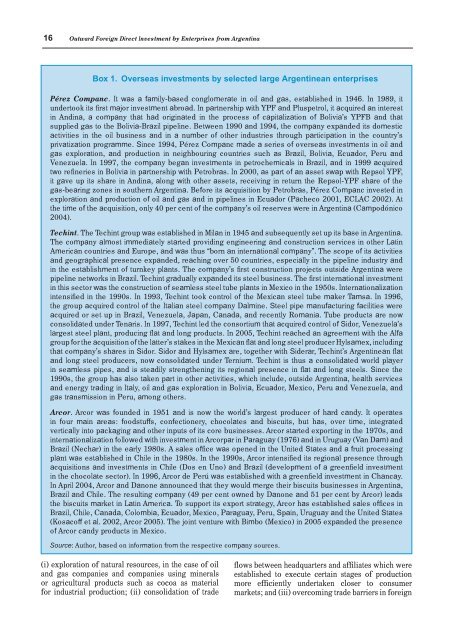Global Players from Emerging Markets: Strengthening ... - Unctad
Global Players from Emerging Markets: Strengthening ... - Unctad
Global Players from Emerging Markets: Strengthening ... - Unctad
Create successful ePaper yourself
Turn your PDF publications into a flip-book with our unique Google optimized e-Paper software.
16 Outward Foreign Direct Investment by Enterprises <strong>from</strong> Argentina<br />
Box 1. Overseas investments by selected large Argentinean enterprises<br />
Pérez Companc. It was a family-based conglomerate in oil and gas, established in 1946. In 1989, it<br />
undertook its first major investment abroad. In partnership with YPF and Pluspetrol, it acquired an interest<br />
in Andina, a company that had originated in the process of capitalization of Bolivia’s YPFB and that<br />
supplied gas to the Bolivia-Brazil pipeline. Between 1990 and 1994, the company expanded its domestic<br />
activities in the oil business and in a number of other industries through participation in the country’s<br />
privatization programme. Since 1994, Pérez Companc made a series of overseas investments in oil and<br />
gas exploration, and production in neighbouring countries such as Brazil, Bolivia, Ecuador, Peru and<br />
Venezuela. In 1997, the company began investments in petrochemicals in Brazil, and in 1999 acquired<br />
two refineries in Bolivia in partnership with Petrobras. In 2000, as part of an asset swap with Repsol YPF,<br />
it gave up its share in Andina, along with other assets, receiving in return the Repsol-YPF share of the<br />
gas-bearing zones in southern Argentina. Before its acquisition by Petrobras, Pérez Companc invested in<br />
exploration and production of oil and gas and in pipelines in Ecuador (Pacheco 2001, ECLAC 2002). At<br />
the time of the acquisition, only 40 per cent of the company’s oil reserves were in Argentina (Campodónico<br />
2004).<br />
Techint. The Techint group was established in Milan in 1945 and subsequently set up its base in Argentina.<br />
The company almost immediately started providing engineering and construction services in other Latin<br />
American countries and Europe, and was thus “born an international company”. The scope of its activities<br />
and geographical presence expanded, reaching over 50 countries, especially in the pipeline industry and<br />
in the establishment of turnkey plants. The company’s first construction projects outside Argentina were<br />
pipeline networks in Brazil. Techint gradually expanded its steel business. The first international investment<br />
in this sector was the construction of seamless steel tube plants in Mexico in the 1950s. Internationalization<br />
intensified in the 1990s. In 1993, Techint took control of the Mexican steel tube maker Tamsa. In 1996,<br />
the group acquired control of the Italian steel company Dalmine. Steel pipe manufacturing facilities were<br />
acquired or set up in Brazil, Venezuela, Japan, Canada, and recently Romania. Tube products are now<br />
consolidated under Tenaris. In 1997, Techint led the consortium that acquired control of Sidor, Venezuela’s<br />
largest steel plant, producing flat and long products. In 2005, Techint reached an agreement with the Alfa<br />
group for the acquisition of the latter’s stakes in the Mexican flat and long steel producer Hylsamex, including<br />
that company’s shares in Sidor. Sidor and Hylsamex are, together with Siderar, Techint’s Argentinean flat<br />
and long steel producers, now consolidated under Ternium. Techint is thus a consolidated world player<br />
in seamless pipes, and is steadily strengthening its regional presence in flat and long steels. Since the<br />
1990s, the group has also taken part in other activities, which include, outside Argentina, health services<br />
and energy trading in Italy, oil and gas exploration in Bolivia, Ecuador, Mexico, Peru and Venezuela, and<br />
gas transmission in Peru, among others.<br />
Arcor. Arcor was founded in 1951 and is now the world’s largest producer of hard candy. It operates<br />
in four main areas: foodstuffs, confectionery, chocolates and biscuits, but has, over time, integrated<br />
vertically into packaging and other inputs of its core businesses. Arcor started exporting in the 1970s, and<br />
internationalization followed with investment in Arcorpar in Paraguay (1976) and in Uruguay (Van Dam) and<br />
Brazil (Nechar) in the early 1980s. A sales office was opened in the United States and a fruit processing<br />
plant was established in Chile in the 1980s. In the 1990s, Arcor intensified its regional presence through<br />
acquisitions and investments in Chile (Dos en Uno) and Brazil (development of a greenfield investment<br />
in the chocolate sector). In 1996, Arcor de Perú was established with a greenfield investment in Chancay.<br />
In April 2004, Arcor and Danone announced that they would merge their biscuits businesses in Argentina,<br />
Brazil and Chile. The resulting company (49 per cent owned by Danone and 51 per cent by Arcor) leads<br />
the biscuits market in Latin America. To support its export strategy, Arcor has established sales offices in<br />
Brazil, Chile, Canada, Colombia, Ecuador, Mexico, Paraguay, Peru, Spain, Uruguay and the United States<br />
(Kosacoff et al. 2002, Arcor 2005). The joint venture with Bimbo (Mexico) in 2005 expanded the presence<br />
of Arcor candy products in Mexico.<br />
Source: Author, based on information <strong>from</strong> the respective company sources.<br />
(i) exploration of natural resources, in the case of oil<br />
and gas companies and companies using minerals<br />
or agricultural products such as cocoa as material<br />
for industrial production; (ii) consolidation of trade<br />
flows between headquarters and affiliates which were<br />
established to execute certain stages of production<br />
more efficiently undertaken closer to consumer<br />
markets; and (iii) overcoming trade barriers in foreign

















